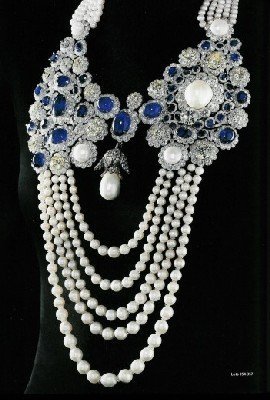PEARLS (Part 3)
One of the greatest bespoke pieces of jewellery ever made surely has to be the diamond and pearl hair ornament Faberge made for the Princess Irina Youssoupov at the turn of the century. Its greatness came not from the design (which was marvellous for its simplicity)but because the ornament housed two of the greatest pearls ever known, La Pelegrina and La Regente.
I have written previously on La Pelegrina’s exciting history, and that of La Regente is no less riveting. The pearl is the fifth biggest in the world and perhaps the biggest of a regular shape. It weighs 302 grains, down from over 346 due to peeling and re-polishing, yet it is still the size of a pigeon’s egg. It has an exceptional colour and lustre and is slightly flat at the back, a characteristic that has made it easy to identify in its journey through history.
Also known as la Perle Napoleon, it came to prominence when Napoleon I bought it as a gift for his second wife, the Archduchess Marie Louise of Austria, Marie Antoinette’s niece. He duly paid through the nose for it, 40000 gold francs, or the weight of 10 kilos of pure gold. Napoleon was trying to awe Europe with the trappings of his newly wrested power and bought jewellery for his new wife, partly to dazzle foreign courts and partly to replete the considerably diminished Crown Jewels. After his defeat at Waterloo La Regente remained with the French Crown Jewels and was worn by the monarchs of the Bourbon restoration. The tiara made by Nitot into which the pearl was originally mounted was dismantled by Napoleon III and he commissioned the jeweller Lemonier to design and make a magnificent devant de corsage in which to sit the pearl. It was a jewel worthy of the opulence of the Second Empire and a favourite of the Empress Eugenie’s, composed of swags of diamonds and pearls and highly stylised acanthus leaves. A matching tiara was also made, and this piece of jewellery was immortalised in Franz Winterhalter’s portrait of her.
The Empress Eugenie wearing ropes of priceless pearls and her famous pearl and diamond tiara. The tiara was sold by the Thurn und Taxis family in the 1990s and acquired by the Louvre.
With the fall of the Second Empire after the Franco-Prussian War the Ministry of Finance took custody of the French Crown Jewels (La Regente included)- Eugenie had been unable to take them with her into exile as they were not personal property. In a fit of historical vandalism, the National Assembly decided to auction off the Crown Jewels in 1887 in order to disperse the symbols of a decadent and discredited regime. From St. Petersburg, Peter Carl Faberge sent his agent to Paris specifically to acquire the famous pearl. It is very probable he had a very special client in mind, the fantastically rich Prince Boris Youssoupov, as that is who it was sold to (the devant de corsage, alas, was probably broken up).
The Youssoupovs could have anything they wanted and their possessions may even have eclipsed those of the Romanovs. Prince Boris’ only child and heir, Zenaida, wore the pearl simply, sometimes suspended off a row of matchless pearls, allowing La Regente’s beauty to speak for itself. Most notably, she sometimes wore it in conjunction with La Pelegrina pearl in a delightfully simple yet highly effective hair ornament. She gifted the pearl to her son Felix in anticipation of his marriage to Princess Irina, Tsar Nicholas II’s niece. They married in 1914, so Princess Irina probably had little chance to wear and enjoy it due to the rarity of grand society events after the outbreak of the First War. The Youssoupovs fled to Paris in August 1917 in the tumult of the Russian Revolution- Prince Felix took with him some of his most prized treasures, amongst them valuable paintings, the Polar Star diamond, La Pelegrina pearl- but not La Regente: that was holed up in his St. Petersburg safe as he assumed he would be able to return to Russia, which of course he never did. The immediate fate of the pearl after that becomes a little murky- it was most likely found by the Bolsheviks after the October Revolution after one of their ransacking of aristocratic palaces for valuable items. La Regente is not to be found in any inventories or the sales the Bolsheviks conducted in their desperation to raise hard currency.
The pearl came up for sale unidentified at Christie’s in 1987, the owners apparently ignorant of its provenance, but they did know it was Russian. It was identified by the buyer (who remained anonymous), one tell tale sign of what he had bought being its slightly flattened back. Firmly back in the spotlight, the pearl was set into an important sapphire, diamond and pearl necklace and was last seen in Christie’s Geneva in 2005- sold by an anonymous buyer to an anonymous buyer for the record price of £1.6 million: it remains the single most expensive pearl in history.
The devant de corsage made for the Empress Eugenie with the La Regente pearl set in the centre
La Regente Pearl in its last known setting.



